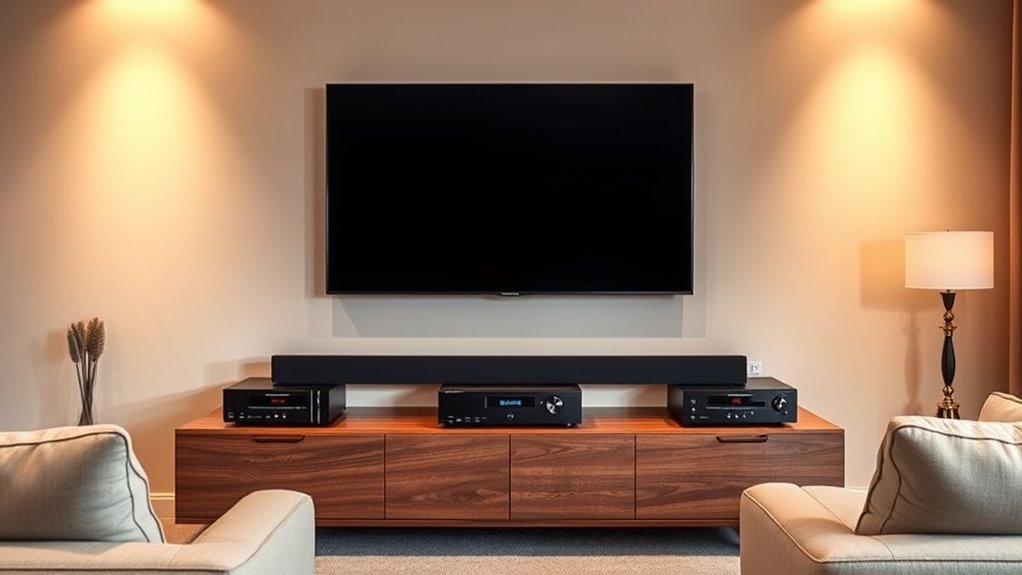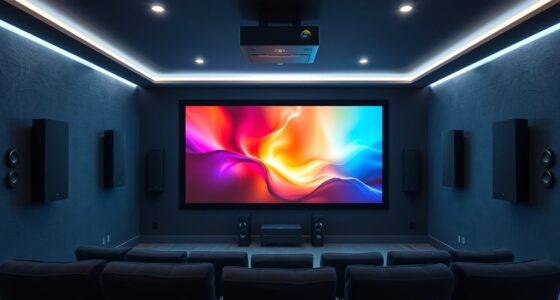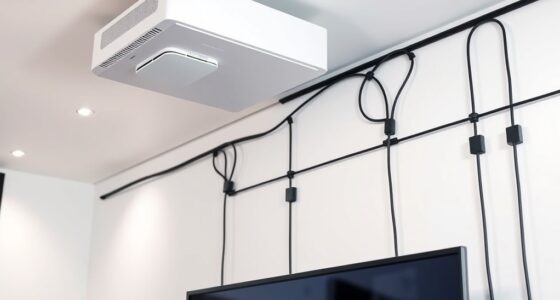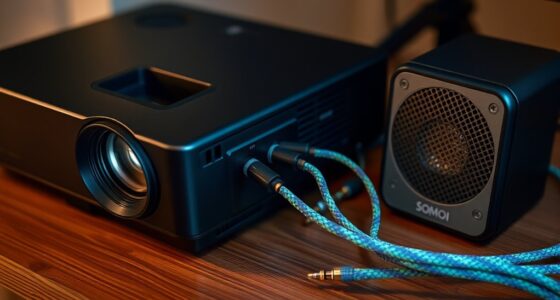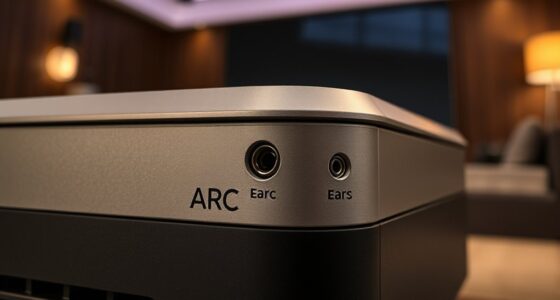When choosing between a soundbar and an AV receiver, consider your space, budget, and desired sound quality. Soundbars are simple, affordable, and ideal for smaller rooms, offering quick setup and sleek design. AVRs provide richer, surround sound and expandability for larger home theaters but come with higher costs and more complex installation. To make the best choice for your setup, discover more details ahead to find what suits your needs.
Key Takeaways
- Soundbars are compact, easy to install, and ideal for smaller spaces, while AVRs support multi-channel surround sound for larger home theaters.
- Soundbars offer a streamlined, budget-friendly option with wireless connectivity, whereas AVRs provide advanced customization and expandability.
- AVRs deliver superior sound quality with immersive surround sound, while soundbars focus on clear, broad audio with simpler setup.
- Soundbars blend seamlessly with decor and reduce clutter, whereas AVRs require more space and complex installation for multiple components.
- Choose a soundbar for simplicity and affordability; opt for an AVR if you desire high performance, flexibility, and future-proof features.
What Is a Soundbar and How Does It Work?

A soundbar is a slim, elongated speaker designed to enhance your TV’s audio without the clutter of traditional home theater systems. It typically connects wirelessly via Bluetooth or Wi-Fi, making setup simple and reducing cable mess. Many soundbars offer sound customization options, allowing you to adjust bass, treble, and volume to suit your preferences. These features help create a richer, more immersive listening experience. Instead of multiple speakers and complicated wiring, a soundbar consolidates audio into a single unit that’s easy to place and operate. Whether you’re watching movies, gaming, or listening to music, the wireless connectivity ensures seamless integration with your devices, while sound customization lets you tailor the audio to match your environment and personal taste. The ability to modify sound settings can also help optimize audio quality for different audio preferences and room acoustics.
Understanding AV Receivers and Their Key Features

While soundbars simplify audio setups, more advanced home theater systems often rely on AV receivers to deliver a truly immersive experience. An AV receiver acts as the hub, managing audio and video signals, and offering features like multi-channel support, multiple HDMI inputs, and surround sound processing. Key features include wireless connectivity options such as Wi-Fi and Bluetooth, which let you stream music effortlessly. A good AV receiver also comes with a remote control, making it easy to adjust settings from across the room. You can customize sound profiles, balance audio channels, and connect various devices seamlessly. Additionally, sound quality enhancement features in AV receivers provide a richer listening experience, giving you greater control and flexibility, elevating your home theater experience beyond what a basic soundbar can offer.
Comparing Audio Quality and Performance

When comparing soundbars and AVRs, you’ll notice differences in sound clarity and depth that can impact your listening experience. The surround sound capabilities of AVRs often create a more immersive environment, while soundbars may focus on delivering clear audio in a compact form. Additionally, volume and power output vary, affecting how well each system fills your space with sound. Resources and Tools can provide further insights into selecting the best audio system for your needs.
Sound Clarity and Depth
Soundbars often deliver impressive clarity and a broad soundstage, making dialogue and details easily distinguishable. Their design allows for ideal speaker placement, which enhances sound clarity and depth. You’ll notice a sharper focus on vocals and clearer sound separation, even at higher volumes. The bass response in many soundbars is surprisingly robust, adding depth without overpowering the main audio. However, because of their compact size, they may struggle with deep bass compared to larger systems. To maximize audio quality, proper speaker placement is key—positioning your soundbar correctly ensures balanced sound and better depth. Keep in mind, some models include subwoofers to improve bass response further, giving your audio a richer, more immersive feel. Additionally, tuning options can help optimize sound performance based on your room acoustics.
Surround Sound Experience
AVRS typically deliver a more immersive surround sound experience compared to soundbars, thanks to multiple speakers strategically placed around the room. This setup creates a true 3D sound environment, making you feel like you’re in the middle of the action. With advanced wireless connectivity, AVRS can easily sync with your streaming devices, ensuring seamless audio transmission without messy cables. Streaming capabilities further enhance your experience, allowing quick access to your favorite content with surround sound effects intact. While soundbars offer decent audio performance, they often struggle to replicate the depth and spatial accuracy of AVRS. If you crave a rich, enveloping sound for movies or gaming, AVRS provide superior performance, especially when combined with reliable wireless connectivity and streaming options.
Volume and Power Output
While both soundbars and AVRS can deliver impressive audio, their volume and power output levels profoundly affect sound quality and performance. Higher speaker wattage means more power, resulting in louder and clearer sound, especially in large rooms. With AVRS, you gain precise volume control across multiple channels, allowing you to fine-tune audio to your preference. Soundbars typically have a set wattage, limiting their maximum volume but still providing rich sound for smaller spaces. If you crave theater-like volume, AVRS usually outperforms soundbars due to their higher wattage and advanced amplification. Keep in mind, the right balance between speaker wattage and volume control ensures ideal performance without distortion. Additionally, contrast ratio impacts how well the audio experience matches the visual environment, enhancing overall immersion.
Installation, Space, and Aesthetics Considerations
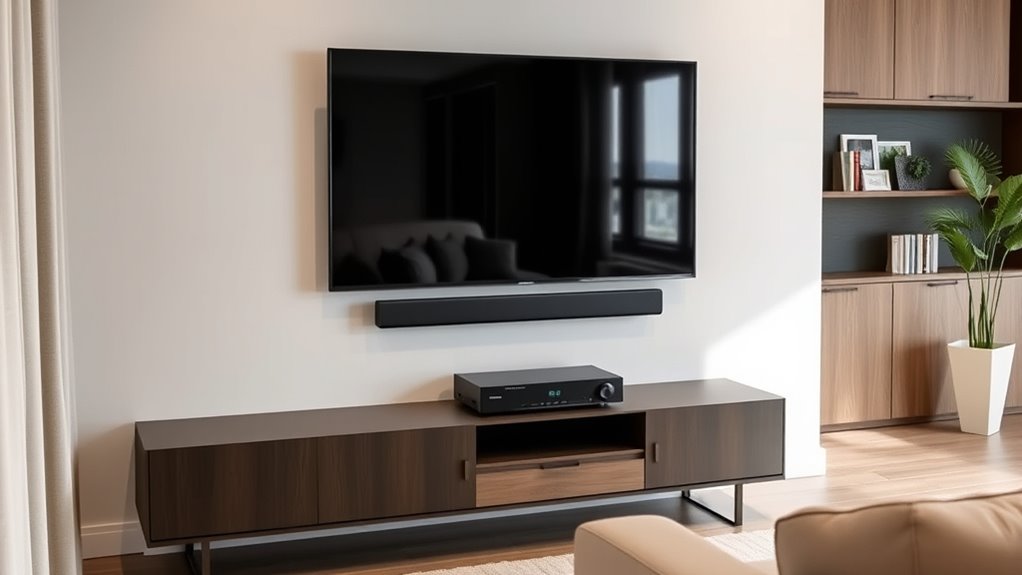
When choosing between a soundbar and an AV receiver, you need to contemplate how much space each setup requires. Aesthetics matter too, as you want your system to complement your room’s design. Additionally, installation ease can save you time and frustration, so weigh how simple it is to set up each option. Considering the decor and overall style of your farmhouse bedroom can help ensure your audio system seamlessly fits into the cozy, rustic environment you aim to create.
Space Requirements
Choosing between a soundbar and an AVRS often depends on your space and aesthetic preferences. Your room size and furniture placement play a vital role in this decision. Soundbars are compact, making them ideal for smaller spaces or rooms with limited clearance, and they don’t require much furniture rearrangement. AVRS, on the other hand, need more space for their components and proper speaker placement, which can influence your room’s layout. Consider these points:
- Room size: Larger rooms may benefit from the immersive sound of AVRS.
- Furniture placement: Adequate space ensures ideal speaker positioning.
- Mounting options: Soundbars are easy to mount under TVs, saving space.
- Space for components: AVRS need shelves or cabinets for receivers and speakers.
- Incorporating room layout considerations can help optimize your space for either system.
Your choice hinges on how much space you can dedicate without sacrificing aesthetics.
Aesthetic Compatibility
Installing a soundbar typically involves minimal effort and space, making it a seamless choice for maintaining a clean, streamlined look. Its compact design often blends effortlessly with your existing decor, enhancing visual harmony without cluttering your viewing area. When considering aesthetic compatibility, a soundbar’s sleek profile can easily integrate with your TV setup or wall decor, creating a cohesive visual aesthetic. Unlike larger AVRs, which may require additional furniture or cabinet space, a soundbar adds to your room’s design without disrupting the overall style. Its unobtrusive presence ensures your entertainment system remains visually appealing, emphasizing design integration rather than detracting from it. Additionally, choosing a soundbar can help reduce clutter in your entertainment area, contributing further to a tidy and organized space. Ultimately, a soundbar offers a subtle, stylish solution that complements your space while delivering excellent audio performance.
Installation Ease
Setting up a soundbar is generally straightforward, requiring minimal effort and space compared to other audio options. It often connects wirelessly via Bluetooth or Wi-Fi, reducing clutter and simplifying placement. Most soundbars come with a remote control, making adjustments easy without needing extra devices. You can mount them directly on the wall or place them on a stand, fitting seamlessly into your space. The installation process is quick, with fewer cables and less technical setup involved. This simplicity makes soundbars ideal if you want a hassle-free upgrade. They also blend well with your existing aesthetic, maintaining a clean look. With features like wireless connectivity and remote controls, you get a sleek, efficient setup without the complexity of traditional AVRs. Additionally, the fan community around fan trailers emphasizes innovative audio setups, inspiring many to explore easy-to-install sound solutions.
Cost and Budgeting Insights
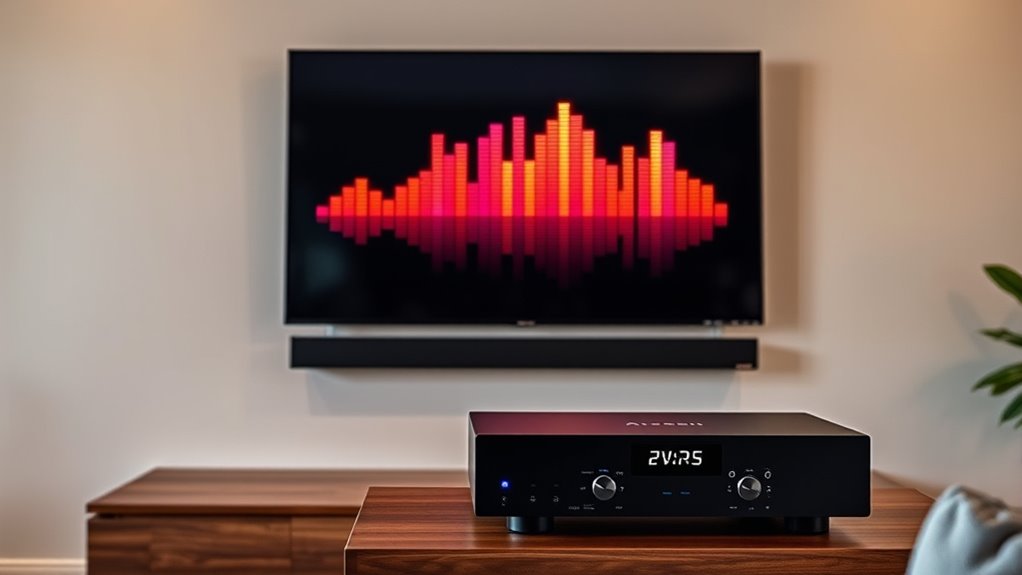
When comparing soundbars and AV receivers (AVRS), understanding their costs is essential for staying within your budget. Soundbars typically cost less upfront, making them ideal for straightforward budget planning. A basic soundbar can start around $100, while premium models reach $1,000 or more. In contrast, AVRs usually involve higher initial expenses, often between $200 and $2,000, depending on features. The cost comparison reveals that soundbars are more affordable and easier to fit into tighter budgets. However, AVRS can offer better sound quality and expandability, but at a higher price. Consider your priorities and how much you’re willing to spend. Knowing the costs upfront helps you make an informed decision aligned with your financial plan. Additionally, understanding the personality traits of users can influence preferences for simplicity versus customization in audio setups.
Flexibility and Expandability Options
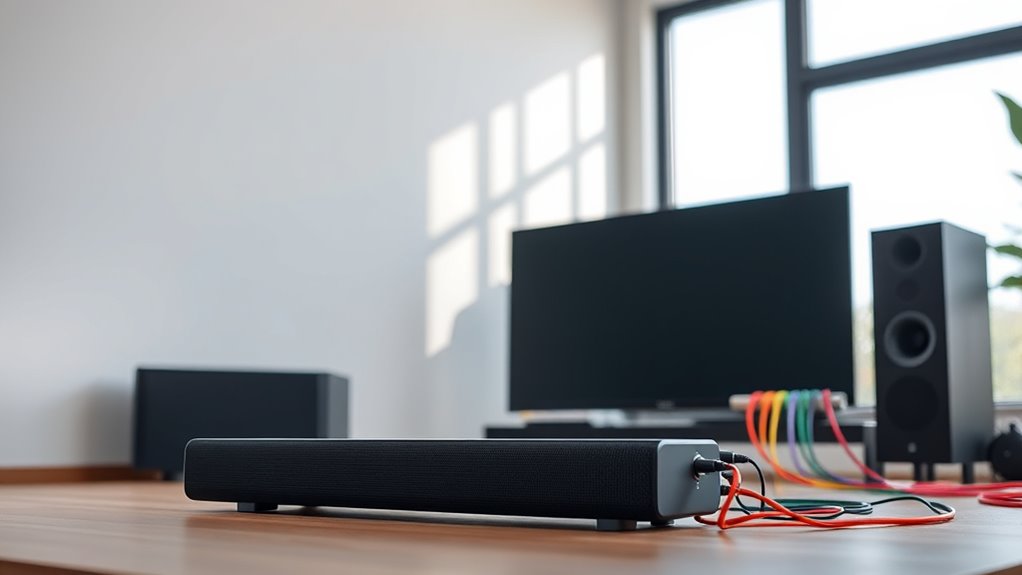
While budget considerations play a significant role in choosing between soundbars and AV receivers, your need for flexibility and expandability can also influence your decision. AV receivers excel here, offering modular components that allow you to customize and upgrade your setup over time. You can add additional speakers, upgrade to higher-quality components, or integrate new technologies easily, making future upgrades seamless. Soundbars, on the other hand, tend to be more limited in this regard. If you value a system that grows with your needs, AVRs provide more options for expansion. Keep in mind these key points:
- Modular components for tailored sound experiences
- Compatibility with new audio formats
- Additional zones for multi-room audio
- Upgradable to support future technology trends
Which Option Is Right for Your Home Setup?
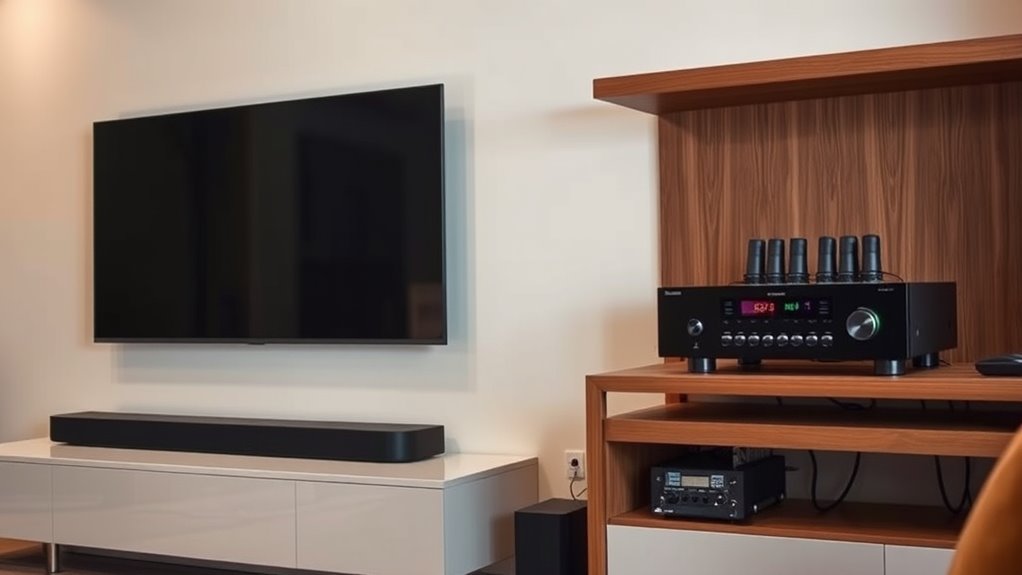
Choosing between a soundbar and an AV receiver depends on your specific home entertainment needs and priorities. If simplicity and minimal setup matter most, a soundbar with wireless connectivity offers an easy solution, often controlled via a remote or smartphone app. It’s ideal for smaller rooms or those who want a sleek, clutter-free setup. On the other hand, if you want a customizable, high-performance system with room-filling sound, an AV receiver is better. It provides multiple connection options, supports wireless connectivity for streaming, and can be controlled through various remotes or apps. Consider how much control you want, your space, and your future expansion plans. Your choice should align with your desired sound quality, convenience, and the level of control you want at your fingertips.
Frequently Asked Questions
Can Soundbars and AVRS Support Multi-Room Audio Setups?
Yes, both soundbars and AVRs can support multi-room audio setups. Many soundbars now feature wireless connectivity options like Wi-Fi or Bluetooth, enabling you to stream surround sound across multiple rooms. AVRs often offer more advanced multi-room capabilities, allowing you to connect various speakers around your home for seamless surround sound. With the right setup, you can enjoy synchronized multi-room audio, enhancing your overall listening experience.
How Do Soundbars and AVRS Handle Different Audio Formats?
Imagine you’re upgrading your home theater; your AV receiver handles various audio formats like Dolby Atmos and DTS:X through advanced audio decoding, ensuring immersive surround sound. Soundbars typically support popular formats via built-in codecs, but may struggle with advanced surround sound formats without external devices. So, your AV receiver offers more extensive audio decoding capabilities, providing richer, more precise sound, while soundbars excel with simpler formats and are easier to set up for everyday use.
Are There Compatibility Issues Between Soundbars and Various TVS?
You might face connection issues or remote compatibility problems when pairing soundbars with certain TVs. Some soundbars use specific HDMI or Bluetooth connections that may not work seamlessly with your TV’s ports or wireless setup. Additionally, remote controls may not be compatible, making it harder to adjust settings. To avoid these issues, check your TV’s output options and make certain your soundbar supports the same connection types and remote functions.
What Are the Maintenance Requirements for Soundbars Vs AVRS?
You need to regularly check your soundbar or AVRS for firmware updates to guarantee peak performance. For soundbars, maintain proper speaker placement to enhance sound quality and prevent damage. AVRS require more upkeep, such as cleaning connections and updating firmware to fix bugs. Both systems benefit from keeping the hardware dust-free and avoiding exposure to moisture, ensuring longevity and consistent audio quality without much hassle.
How Do Warranties and Customer Support Compare for Both Options?
Warranty coverage and customer service quality tend to favor AVRs, offering longer warranties and more extensive support. AVRs often come with multi-year warranties that cover parts and repairs, and manufacturers typically provide dedicated customer service channels. Soundbars usually have shorter warranties and limited support. If you prioritize reliable customer service and extended warranty coverage, AVRs are generally the better choice, giving you peace of mind and easier assistance if issues arise.
Conclusion
So, now that you’re armed with all the facts, you can confidently decide whether a sleek soundbar or a mighty AV receiver is your perfect audio sidekick. Of course, if you’re feeling overwhelmed, just remember: nobody ever lost a fight with a pizza and a remote in hand. Whatever you choose, make sure it’s loud enough to drown out your neighbor’s lawn mower—because life’s too short for mediocre sound.
